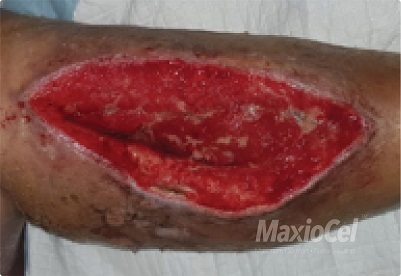FEMORAL DEEP VEIN THROMBOSIS
MaxioCel - 100% Chitosan Wound Dressing on Femoral Deep Vein Thrombosis
Center
INDO VASC Hospital , Ahmedabad-Iindia: Dr. Srujal Shah
Patient details: 65 years, Female
Comorbidities: Diabetes & Hypertension
Patient symptoms: Patient suffering from extreme pain and exudating wounds
Diagnostic Evaluation:
Stage 1 – Emergency IVC filter placement.
Stage 2 – Open Venous Thrombectomy
Stage 3 – Wound debridement for dead ischemic calf muscles
Stage 4 – VAC Therapy for large calf wound
Stage 5 – Suturing under LA with drain
Confirmed: Massive iliofemoral DVT presented as phlegmasia cerulea dolens No of Maxiocel used & Duration 4 Maxiocel; results received in 2 weeks


Wound before using Maxiocel


Woundafter using Maxiocel and
complete healing seen
Result
| Patient Outcome with Maxiocel | Ease of Application/Removal | Antimicrobial barrier | Wound adherence | Conformability | Wound scar improvement | Pain management |
| Excellent | ✓ | ✓ | ✓ | ✓ | ✓ | ✓ |
| Good | ||||||
| Fair | ||||||
| Poor |
Discussion
- Venous thromboembolism (VTE) is the most serious and potentially fatal complication that can arise from DVT. Venous conditions are implicated in compromised wound healing. Postthrombic syndrome is caused by persistent outflow occlusion, scarred or incompetent valves, and dependent positioning of lower extremities. Both venous ulceration and chronic venous insufficiency are exacerbated by increased venous hypertension; thus, often postthrombotic syndrome is demonstrated even in the absence of DVT Consequently, patients with venous ulcers should have their venous disease carefully evaluated to determine if past or present increased venous hypertension is contributing to delayed healing. One study demonstrated the most important factor affecting ulceration and ambulatory venous pressure in post DVT patients was valvular incompetence. Ulceration did not occur in patients with persistent occlusion and competent valves. Similar findings of the importance of valvular competence were reported in another study assessing long-term sequelae of DVT. Because 80% to 85% of all leg ulcers are associated with venous hypertension, compression and leg elevation remain key factors in alleviating symptoms and promoting healing.
- MaxioCel is a non-woven microfibre dressing made up of 100% Chitosan, is highly absorbent antimicrobial dressing with pain reduction and scar improvement properties. It can be used for moderate to heavily exuding wounds of varied depth, shape and size.
- Overall, MaxioCel was also found to be an excellent chitosan wound dressing in patients suffering from Femoral DVT
 A collaborative study with Harvard Medical School
A collaborative study with Harvard Medical School